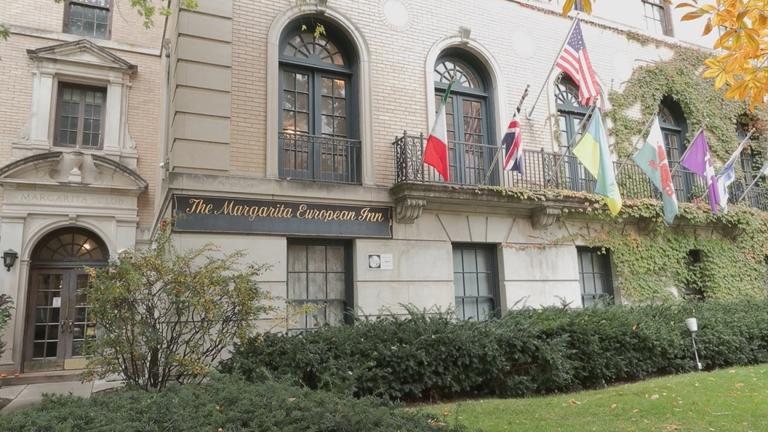A badger caught in Cook County was surgically implanted with a transmitter by veterinarians with the Chicago Zoological Society and released into the wild so researchers can track it and study its day-to-day habits. (Jeff Nelson)
Badgers are known for their elusiveness: the mostly solitary animals travel and forage at night, moving from one place to another quickly.
But wildlife biologists recently got lucky and caught one in northwest Cook County. With the help of a surgically-implanted transmitter, they'll track and study the badger to uncover its habits and interactions with the local environment.
The Cook County Forest Preserve and Chicago Zoological Society, which operates the Brookfield Zoo, used a modified foothold trap to humanely catch the 21-pound adult male badger.
After determining the badger was healthy and fully grown, a transmitter containing a coiled antenna was surgically placed inside its abdomen before the badger was released back into the wild. Researchers will use a multi-pronged directional antenna to track the animal via the transmitter’s signal – a process called triangulation.
“Every day we’ll be looking to see where the badger goes and what he’s up to,” said Chris Anchor, senior wildlife biologist at the Cook County Forest Preserve. “We’ll monitor his behavior and habits – whether he’s foraging, traveling or resting.”
Chris Anchor, senior wildlife biologist for the Cook County Forest Preserve, using a directional antenna to track the movements and location of the badger. (Jeff Nelson)
Badgers belong to the mustelid family, which includes weasels, otters and wolverines. They have broad, relatively flattened bodies with short, stout legs. They’re distinguished by the white markings on their black face. Their low position to the ground, along with their strong shoulders and front legs, with webbed claws up to two inches long, make them expert diggers. Badgers burrow into the ground to catch common prey like gophers, prairie dogs, ground squirrels and rats, but they’ll also eat ground nesting birds, snakes, insects and plants.
Don’t be fooled by the badger’s relatively unintimidating appearance: these fierce animals are apex predators, meaning they’re at the top of their food chain and have no natural predators.
“There’s nothing in our area that will mess with a badger,” Anchor said. “A whole family of coyotes could come up to a badger feeding on a road-killed deer, but they won’t touch it until the badger’s done. The badger will charge and attack.
“They’ll try to fend off the badger and bite it but its legs are too short and it has loose fur, so the only thing the coyote can bite is skin. The coyote has a lot of exposed areas to exploit. A badger will clamp down and break one of its long legs. The other coyotes won’t stick around after that.”
 Dr. Jennifer Langan, senior staff veterinarian with the Chicago Zoological Society, examines the badger's claws before it's released back into the wild. (Jim Schulz / Chicago Zoological Society)
Dr. Jennifer Langan, senior staff veterinarian with the Chicago Zoological Society, examines the badger's claws before it's released back into the wild. (Jim Schulz / Chicago Zoological Society)
Due to their high metabolisms, badgers are constantly in search of their next food source and rarely in the same spot for long, unless a mother is rearing her young, according to Anchor.
“Generally, by the time you notice a badger was somewhere, they’re already gone,” Anchor said. “I’ve been in this position for 30 years and every year, I handle 800 to 1,200 animals. This is only the fourth badger I’ve ever handled.”
Based on the wearing of its teeth, researchers estimated the badger they caught is about three years old. Blood and tissue samples were taken and will be preserved for future research and testing of antibodies to see what viruses or diseases the animal may have been exposed to.
“In these urban environments, there are lots of diseases that move between people, domestic animals and wildlife,” said Dr. Mike Adkesson, vice president of clinical medicine at the Chicago Zoological Society. “By having a good understanding of what diseases are present in the wildlife populations, it allows us to work towards public safety as well as conservation to protect wildlife from contracting diseases.”
As Adkesson puts it, these are “difficult animals to lay eyes on,” so just how many badgers are living in Cook County is unknown. By tracking this badger, he said they're hoping to better understand how many are in the area, how far they’re traveling and what other wildlife they’re in contact with.
Last year, the Cook County Forest Preserve and Chicago Zoological Society similarly trapped and began tracking a North American river otter, another mustelid and apex predator. Anchor said the Forest Preserve currently has transmitters on or inside about 25 different species of animals.
Follow Evan Garcia on Twitter: @EvanRGarcia
Related Stories
 Peru’s Protected Treasure: Reserve is Key for Conservation
Peru’s Protected Treasure: Reserve is Key for Conservation
March 24: A small nature reserve at a tiny point on the southern coast of Peru is playing a big role in protecting endangered marine and bird species. Learn how the Chicago Zoological Society has been working with the community to engage locals in the conservation effort.
 Rescued Baby Sea Otter Finds Home at Shedd Aquarium
Rescued Baby Sea Otter Finds Home at Shedd Aquarium
February 17: A 10-week-old sea otter pup rescued after a rough storm in California last month is recovering at her new home in Chicago.







